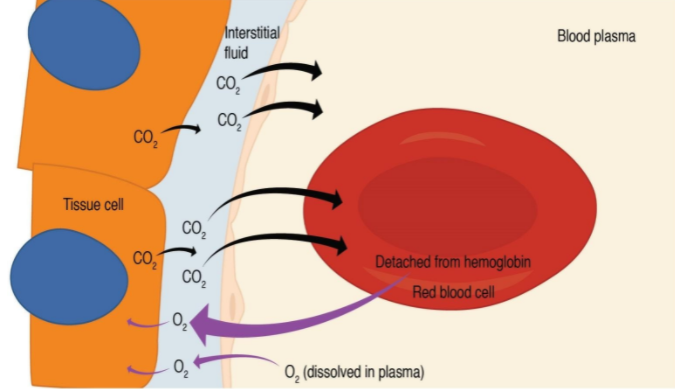
What happens in internal respiration?
Answer
492.9k+ views
Hint: Respiration is the process of taking in oxygen and giving out of carbon dioxide. The oxygen is used to oxidise glucose so as to liberate energy in the form of ATP. Respiration is of two types external and internal. In internal respiration, the gaseous exchange occurs between the blood and the cells.
Complete answer:
The main organ of respiration in our body is the lungs. We breathe in oxygen and give out carbon dioxide. The gaseous exchange takes place at the alveoli where oxygen and carbon dioxide are exchanged between the alveoli and the blood. This is known as external respiration. The gaseous exchange further takes place between the blood and the cells. This is termed internal respiration.
Let us discuss in detail internal respiration-
The gaseous exchange mainly occurs through diffusion. The carbon dioxide is given out as waste and oxygen are taken in. In internal respiration, the oxygen from the blood diffuses to the cells of the body. The oxygen is transported by the haemoglobin present in the blood. It is further transported to various cells through the blood stream.
The diffusion takes place between the bloodstream and the cells. Once the oxygen reaches every cell, the glucose is metabolised by the process of glycolysis in the cytoplasm and further, the release of energy takes place in mitochondria. The energy released is utilised by the cells to carry out other metabolic activities.
The diffusion of gases is shown in the figure below.

Note: The respiration which takes place in the presence of oxygen is known as aerobic respiration. In certain cases, like during strenuous exercise, due to lack of oxygen, the muscles respire anaerobically and forms lactate. This lactate is deposited in the muscles is the main reason cause fatigue.
Complete answer:
The main organ of respiration in our body is the lungs. We breathe in oxygen and give out carbon dioxide. The gaseous exchange takes place at the alveoli where oxygen and carbon dioxide are exchanged between the alveoli and the blood. This is known as external respiration. The gaseous exchange further takes place between the blood and the cells. This is termed internal respiration.
Let us discuss in detail internal respiration-
The gaseous exchange mainly occurs through diffusion. The carbon dioxide is given out as waste and oxygen are taken in. In internal respiration, the oxygen from the blood diffuses to the cells of the body. The oxygen is transported by the haemoglobin present in the blood. It is further transported to various cells through the blood stream.
The diffusion takes place between the bloodstream and the cells. Once the oxygen reaches every cell, the glucose is metabolised by the process of glycolysis in the cytoplasm and further, the release of energy takes place in mitochondria. The energy released is utilised by the cells to carry out other metabolic activities.
The diffusion of gases is shown in the figure below.

Note: The respiration which takes place in the presence of oxygen is known as aerobic respiration. In certain cases, like during strenuous exercise, due to lack of oxygen, the muscles respire anaerobically and forms lactate. This lactate is deposited in the muscles is the main reason cause fatigue.
Recently Updated Pages
Why are manures considered better than fertilizers class 11 biology CBSE

Find the coordinates of the midpoint of the line segment class 11 maths CBSE

Distinguish between static friction limiting friction class 11 physics CBSE

The Chairman of the constituent Assembly was A Jawaharlal class 11 social science CBSE

The first National Commission on Labour NCL submitted class 11 social science CBSE

Number of all subshell of n + l 7 is A 4 B 5 C 6 D class 11 chemistry CBSE

Trending doubts
Differentiate between an exothermic and an endothermic class 11 chemistry CBSE

10 examples of friction in our daily life

One Metric ton is equal to kg A 10000 B 1000 C 100 class 11 physics CBSE

Difference Between Prokaryotic Cells and Eukaryotic Cells

1 Quintal is equal to a 110 kg b 10 kg c 100kg d 1000 class 11 physics CBSE

State the laws of reflection of light




